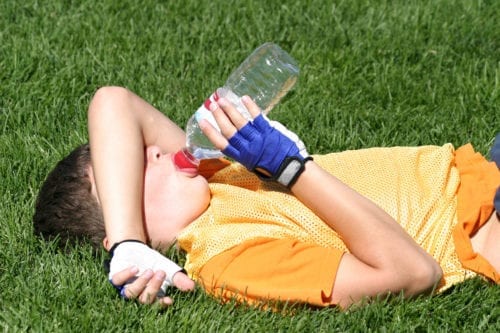As Spring approaches in Mississippi, warmer temperatures are just around the corner. With the extreme heat and humidity of Mississippi summers, it is important to recognize and treat heat related illness in children, as well as prevent it from the start.
Children account for almost half of all reported incidences of heat related illness. Of those, exercising adolescents and children left unattended in vehicles are the most common. Obviously, the second of these is prevented by not leaving small children unattended in vehicles on hot days, but it is important to realize that interior car temperatures can reach extremes even when the ambient temperature isn’t really high. One study showed that the interior of a car can reach 117 degrees within 60 minutes with the outside temperature only 72 degrees. Contrary to popular belief, cracking the windows of the car does very little to alter this effect. Thus, children should NEVER be left unattended in vehicles.
Preventing heat related illness in exercising adolescents is a little more complex. Football players are at the highest risk of heat related illness and the most common month for this to occur is August — when practices are ramping back up for the fall with deconditioned athletes. Certain conditions increase the risk of heat related illness in athletes: diseases (such as sickle cell, cystic fibrosis, or diabetes), obesity, medications, alcohol use, and general deconditioning. Also, recovering from a recent febrile or gastrointestinal illness can lead to more rapid dehydration and heat related illness. All athletes should undergo a preparticipation history and physical from their regular health care provider (the yearly wellness visit or check-up) to identify any risk factors for heat related illness. Young athletes should also be encouraged to wear light colored clothing that is lightweight, loose-fitting, and made from sweat wicking material.
Sweat soaked garments should be removed promptly to facilitate heat loss from evaporation. Athletes should be diligent to hydrate before, during, and after physical exertion. Fluids should be readily available and there should be dedicated times for hydration offered during practices and games. Having flavored hydration products (sports drinks) available has been shown to increase consumption and decrease dehydration. Coaches should be counseled to have fluids available, as well as to gradually ramp up activities to allow students to acclimate. Practices should also be scheduled in the cooler times of the day.
Signs of heat related illness in children and adolescents include sweaty or flushed skin with muscle cramps, nausea and vomiting, increased heart rate or respiratory rate, and mental changes such as headaches, dizziness, or confusion. If a child shows these signs, he or she should stop activities and begin cooling procedures immediately. First, the child should be moved to a cooler environment (shady spot or indoors) and sweaty clothing should be removed. The child should be offered cool fluids to drink if he or she is able. For older children, cold water immersion (such as an ice bath) is the best cooling method. Placing the child in a cold shower is also a good option. Using cold, wet towels to the head and neck area is another easy option for rapid cooling when immersion is not possible. For young children, strategies such as spraying the child with cool water and using fans to circulate air are safer. If a child does not respond to cooling measures or shows any signs of confusion, he or she should be transported to the nearest emergency room immediately.
Mississippi summers and outdoor sports and games can be great times of enjoyment for kids and families. Being prepared for the heat can help everyone to enjoy the events!
Article submitted by Dr. Jaye K. Myers of Children’s Medical Group

